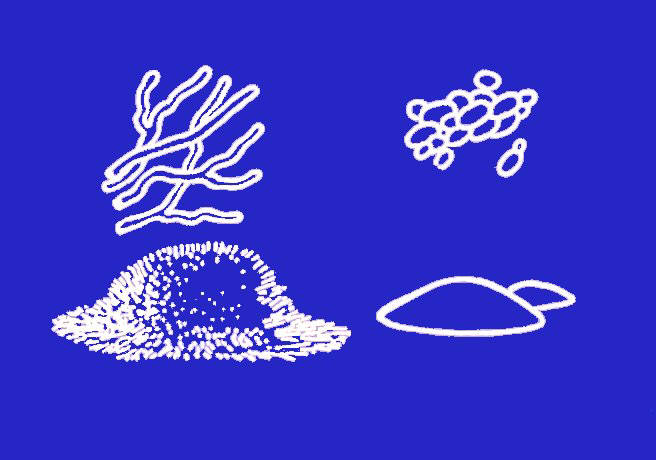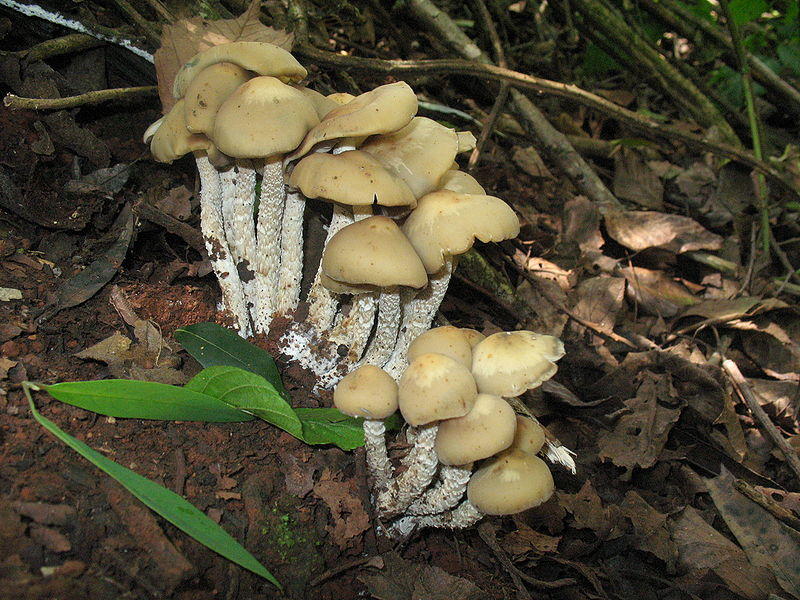Kingdom Fungi – Types, Characteristics, Examples and Pictures of Fungi
What Are Fungi?
Fungi are a group of living organisms, consisting from unicellular yeasts, and multicellular molds and mushrooms.
A word fungus, plural fungi, is adopted from Latin fungus (mushroom), from Greek sphongos (sponge), and refers to a physical appearance of fungi. Mycology (from Greek mykes = fungus) is a branch of biology dealing with fungi.
Beneficial and Harmful Fungi
Some fungi are beneficial: they decompose dead organisms, they can be used in production of food, they are part of normal human flora. Other fungi are pathogenic, meaning they may cause diseases (mycoses) in plants, animals and human. Certain fungi, like Candida albicans, can be beneficial when present in small amounts in body tissues, but can overgrow in certain circumstances, like low immunity and become harmful (opportunistic fungi).
Types of Fungi
Fungi can be, on the basis of their structure, divided into three types:
1. Yeasts
Yeasts are unicellular fungi. Examples:
- Saccharomyces cerevisiae – baker’s or brewer’s yeast
- Saccharomyces boulardii is a part of normal intestinal flora; available in pharmacies as probiotic, which can prevent antibiotic associated diarrhea.
- Pityrosporum ovale, a part of normal skin flora can be converted to a pathogenic form Malassezia furfur and cause tinea versicolor or ringworm infection of the skin.
- Candida albicans is normally present in the mouth, esophagus, bowel and vagina; if it overgrows, it may cause oral thrush, esophageal, bowel or vaginal yeast infection; usually only in persons with lowered immune system. If candida invades the blood, it may cause life threatening systemic candidiasis.
- Cryptococcus neoformans can cause cryptococcosis or cryptococcal meningitis (an infection of the brain membrane)
2. Molds
Molds (moulds in British English) are multi-cellular fungi. Common genera are:
- Penicillium was originally used to produce antibiotic penicillin; also used in production of cheese
- Aspergillus commonly contaminates starchy foods, corn (maize) and peanuts; certain species secrete mycotoxins that can cause miscarriages, inborn defects, liver cancer. Aspergilus may cause aspergilloma (fungus ball) in lungs or paranasal sinuses, and localized or systemic aspergillosis.
- Rhizopus molds appear on old bread, decaying fruit and vegetables, feces, etc.
- Mucor causes a rare mucormycosis.

Picture 1. Left: Molds with their multi-cellular filaments appear as fuzzy growths
Right: Unicellular yeasts appear as a smooth growth
(source: phil.cdc.gov)
A term mildew refers either to certain kinds of mold or to mold growth on plants, walls, leather, paper, cloths, etc.

Picture 2. Mildew (mold growth) on the ceiling and walls
(source: Wikimedia)
3. Mushrooms
Mushroom is the fleshy fungus growing from soil or trees. It typically consists from a stem, cap and gills (lamellae).

Picture 3. Hallucinogenic Psilocybe zapotecorum mushroom
(source: Wikimedia)
Kingdom Fungi – Classification and Characteristics of Fungi
Fungi belong to kingdom Fungi and can be clearly distinguished from other four kingdoms of life: Animalia (animals), Plantae (plants, including algae), Monera (including bacteria) and Protista (including amebae) by a combination of the following characteristics:
- Fungi contain membrane-bound nucleus (like plants and animals but unlike bacteria), so they are eukaryotes (Greek Eu = true;karyon = nucleus).
- They contain cell wall made of chitin (unlike plant cells with cellulose walls and animal cells, which have no cell wall).
- They have no chlorophyll (like plants and algae have), so they do not produce food by photosynthesis, but they have to obtain it from organic matter from their environment, so they are heterotrophes (Greek heteros = another; trophe = nutrition).
- They do not ingest food, but secrete enzymes, which digest food outside of their bodies, and then absorb obtained nutrients.
- Multi-cellular fungi grow by extension of thin, tubular threads called hyphae through which they absorb nutrients. Hyphae may branch and form mycelium.
- Fungi reproduce by sexual or asexual spores (which are usually spread by air), or by budding.
Kingdom fungi includes five phyla (classes) or divisions (1):
- Chytridiomycota (Greek chytra = pipkin) or chytrids, which mainly live in fresh and seawater
- Zygomycota (Greek zygon = yoke, bond); example: Rhizopus stolonifer or black bread mold
- Glomeromycota (Greek glomus = ball shapped mass) or soil fungi are connected to roots of some plants
- Ascomycota (Greek askos = sac) or sac fungi; examples: Saccharomyces cerevisiae or baker’s yeast, colored molds on foods, Penicillium, morels, truffles, yeasts. Lichens are symbiotic associations between Ascomycetes and certain green algae.
- Basidiomycota or club fungi; examples: mushrooms, puffballs; some species break down wook and some cause plant diseases like rusts and smuts
Two additional phyla were suggested:
- Microsporidia
- Neocallimastigomycota
Fungal Diseases in Human
Fungi can cause fungal skin or vaginal infections, oral thrush, allergies, severe systemic infections like invasive candidiasis or aspergillosis, and even cancer.
Related Articles:
References:
- Kingdom Fungi – five division – facts (pierce.ctc.edu)


